मूंगफली के 10 महत्वपूर्ण कीट और उसका प्रबंधन
Groundnut is an important oil seed crop out of the nine oilseeds crops grown in our country, Groundnut is the only crop cultivated in Goa during both the seasons. The major area under this remunerative crop [1437 ha] however is during the Rabi season.
Groundnut crop is infested with sucking type of insects pests like aphids, leaf minor thrips leaf eating caterpillars, leaf webber etc in the initial and active growth stages. In the later stages, the crop may be attacked by pests like Groundnut earwig or pod borer which punctures the developing pods causing heavy damage.
1. Ground nut Aphid: Aphis craccivora Koch.
Damage
Ground nut aphid injects a powerful toxin into the plant while feeding and, when populations are large, this can stunt or kill plants. While feeding, this aphid produces a considerable amount of honeydew upon which sooty mold grows. The black sooty mold reduces photosynthesis and may make leaves unpalatable to livestock.
Damage symptoms include yellowing, wilting, and dieback. In general, legumes can be seriously damaged, either by direct insect feeding or by the transmission of virus diseases (Rossette & Peanut strip virus.)
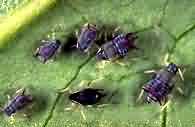
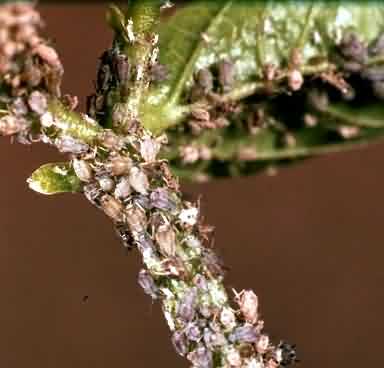
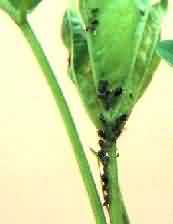
Control
- inella septumpunctata,Menochilus sexmaculatus & Chrysoperla carnea keeps the pest under check. ( if 1 predator per plant no need of insecticide application.) Grow cowepea +Ground nut.
- Phosphamidon 0.03 %
- M-O-D 0.025 %
- Dimethoate 0.03 %
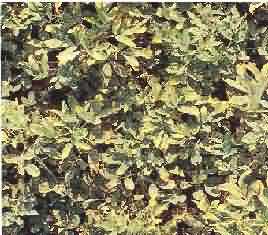 2. Jassids: Empoasca kerri Bachluchaspp.
2. Jassids: Empoasca kerri Bachluchaspp.
Damage
Both adults and nymphs suck sap from young leaves, mostly from the lower surface. The first symptom of attack is a whitening of the veins. Yellow patches then appear, especiallythe tips of leaflets.
Under severe infestation, the leaf tips become necrotic in a typical 'v' shape, giving the crop a scorched appearance known as 'hopper burn' The eggs are inserted in to the leaf tissue close to the midrib or into the petiole.
The egg hatch in a week and nymphs in to adult in 10 days. The infestation is high during August and September and February and March.
Control
In the initial crop growth i.e. up to 30 days after emergence, if more than 10% of all leaves have the characteristic 'hopper burn', apply Dimethoate at 200-250 ml a.i./ha.
Cultural Control
- Tmely sowing of the crop and field sanitation.
- Grow tolerant varieties like Girnar 1. Crop rotation with non host crop.
- Intercropping with pearl millet, Avoid groundnut-castor inter crop, it increases the infestation.
- Irrigate once to avoid prolonged mid season drought to prevent pre-harvest.
Mechanical Control
Collect and destroy the affected parts of the plant
Biological Control
Conserve bio agents like praying mantis, long horned grass hoppers, dragon flies spiders, green muscardine fungus.
Chemical Control
- Apply safe chemical insecticides at recommended doses only if the insect population crosses the ETL.
- Spray dimethoate 30EC @ 650ml/ha or Monochrotophos 36SL @ 600ml/ha in 600 liter water.
3. Thrips: (Scirtothrips dorsalis, Thrips palmi)
Damage
Nymphs and adults lacerate the surface of the leaflets and suck the oozing sap resulting in white patches on lower surface of the leaves and distortion of young leaflets. Severe infestations cause stunted plants. Thrips palmi transmits peanut bud necrosis.
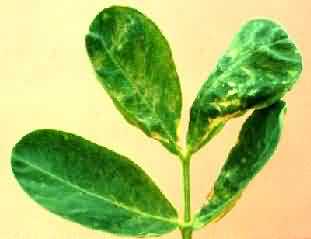
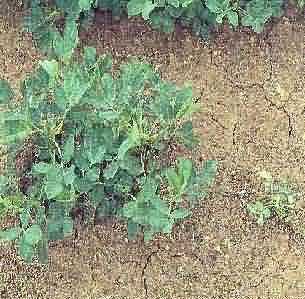
Cultural Control
- Grow tolerant varieties like ALR 3, Robut 33-1, Kadiri 3 and ICGS 86031
- Several groundnut accessions like 21018 have been identified as resistant to thrips.
Mechanical Control
Uproot and destroy severely infected plants.
Biological Control
Conserve bio agents like flower bugs (anthocorids), lady bird beetles (coccinellids), praying mantis, green lace wing (chrysopids), long horned grass hoppers, dragon flies and spiders.
Chemical Control
- Spray Monochrotophos 36SL 600 ml/ha or Dimethoate 30 EC 650ml/ha or Methyldemeton 25 EC 600 ml in 600 lit of water.
- Spray per acre monocrotophos 320ml mixed with neem oil 1lit and 1kg soap powder mixed in 200lit of water twice at 10days interval.
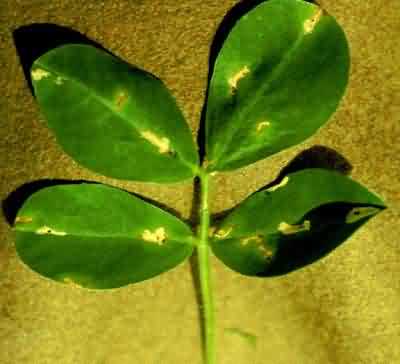 4 Leaf miner Aproaerema modicella
4 Leaf miner Aproaerema modicella
Nature of damage
Small blister like mines are seen on the upper leaf surface near mid rib. As the feeding advances, the mines increase in size and the entire leaflet becomes brown, rolls, shrivels and dries up.
In severe cases the affected crop presents a burnt up appearance. Later stages larvae web the leaflets together and feed on them, remaining within the folds.
Control:
Physical
The adult moths are attracted to light from 6.30 to 10.30 P.M. Petromax lamp placed at ground level attracts moths.
Cultural
- Crop rotation with non-leguminous crops would considerably reduce the leafminer population.
- Rotation of groundnut with soyabean and other leguminous crops should be avoided.
- The most promising method of control would be utilization of resistant/tolerant varieties.
Chemical
- Monocrotophos 0.04 %, DDVP 0.05 %, Fenitrothion 0.05 %, Endosulfan 0.07 %, Carbaryl 0.2 %, Quinalphos 0.05 %.
- Larva is parasitized by Bracon gelechidae Ashm. & Elasmus brevicornis Gah.
5 Gram pod borer: Helicoverpa armigera
Damage
Larvae feed on the foliage, prefers flowers and buds. When tender leaf buds are eaten symmetrical holes or cuttings can be seen upon unfolding of leaflets.
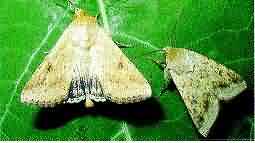
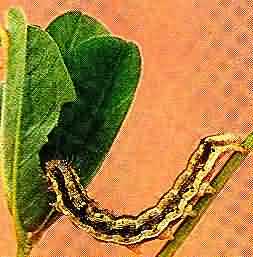
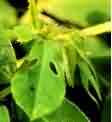
Cultural Control
- Deep summer ploughing
- Intercrop one row of red gram for every 5 or 6 rows
Mechanical Control
Install pheromone trap @ 5/ha
Biological Control
- Use Trichogramma chilonis @ 1 lakh/ha or Chrysoperla carnea @ 50000/ha at 40 and 50 days after sowing of groundnut can effectively check the pest.
- Apply H-NPV @ 250 LE/ha or B.t (Bacillus thuringiensis) 1 kg/ha or 5% NSKE Conserve the natural bio control population of spiders, long horned grasshoppers, praying mantis, robar fly, ants, green lace wing, damsel flies/dragon flies, flower bugs, shield bugs, lady bird beetles, ground beetle, predatory cricket, earwig, braconids, trichogrammatids, NPV, green muscular fungus.
- Crop rotation with sorghum, maize, pearl millet and
- sugarcane minimizes the infestation.
- Chemical control as per polyphagous pests
6. Tobacco caterpillar Spodoptera litura
Damage
Freshly hatched larvae feed gregariously, scraping the chlorophyll, soon disperse. Later stages feed voraciously on the foliage at night, hiding usually in the soil around the base of the plants during the day. Sometimes the feeding is so heavy that only petioles and branches are left behind. In light soil, caterpillar bores into the pods.
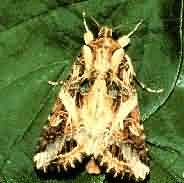
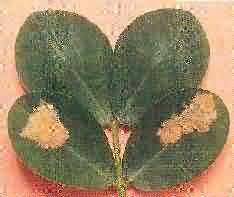

Management
- Set up pheromone traps at 2 traps/ha to monitor the adult (moth) populations.
- Grow castor or sunflower along the border and irrigation channels as an indicator or trap crop.
- Collect the gregarious early stages caterpillars in clusters (which manifest the lace-like leaves by their feeding) on castor or sunflower and destroy them.
- Avoid migration of caterpillars by digging a trench 30 cm deep and 25 cm wide with perpendicular sides around the infested fields.
- Apply nuclear polyhedrosis virus (NPV) at 250 LE (larval equivalents)/ha with sugar 2.5 kg/ha in the evening hours. Sugar acts as a sticker and as a stimulant.
- Prepare bait with the following materials to cover one hectare.
- Rice bran 12.5 kg, molasses 2.5 kg and Carbaryl 50 WP 1.25 kg.
- Mix the ingredients to a homogeneous mixture, sprinkle water gradually and bring the bait to a dough consistency.
- Distribute the above bait on the soil, around the field and inside in the evening hours immediately after preparation.
- In irrigated and high-input-use areas. Apply any one of the following insecticides to control early stages of caterpillar:
- Carbaryl 10 D-25 kg/ha;
- Carbaryl 50 WP 2.0 kg/ha;
- Quinalphos 20 EC-750 ml/ha;
- Endosulfan 35 EC- 1.0 liter/ha;
- Dichlorvos 76 WSC – 750 ml/ha;
- Indoxacarb 14.5 SC- 250 ml/ha;
- Spinosad 45 SC – 125 ml/ha.
7. Ground nut White grub: Holotrichia consanguinea
It is a polyphagus pest. Adults are 18-20 mm long and 7-9 mm wide. The eggs are white, almost round. The young grubs are translucent, white and 5 mm long. Beetles emerge out of the soil within 3-4 days after the onset of rain. Install light traps with the onset of rains and count the number of beetles per day. Dig 100 X 100 X 20 cm pit @ 10 pits per ha, collect and count the number of beetles per pt.
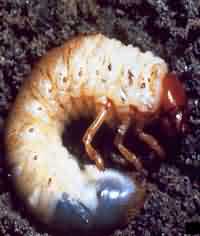
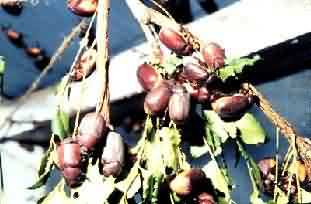
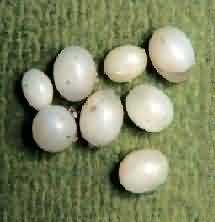
Damage
Both adults and larvae are damaging stage.The larvae feeds roots and damage pods. Grubs feed on fine rootlets, resulting in pale, wilted plants dying in patches.
Mechanical Control
Collection and destruction of white grub adults from host trees around the field. In areas where white grub is persistent problem, deep ploughing after harvesting the crop can reduce the population as birds can pickup the grubs, and destruction of pupae.
Biological Control
Conserve braconids, dragon flies, trichogrammatids, NPV, green muscardine fungus.
Chemical Control
- Apply safe chemical insecticides at recommended doses only if the insect population crosses the ETL.
- Control white grub adults by spraying their feeding trees like neem etc. with Carbaryl 50 WP at 2 g per liter of water. OR Chlorpyriphos 20 EC @ 2 ml/lit of water soon after first monsoon showers for 3-4 days in the late evening hours kills the adult beetles and reduces root grub infestation.
- This spraying need to be repeated 3 to 4 times until mid-July, ideally using community approach.
- Application of Carbofuran at 1 kg a.i./ha in the seed furrows can be effective prophylactic measure.
- Seed treatment with chlorpyriphos 20 EC ( 6.5 to 12.5 ml/kg seed) is found effective.
- In case of severe infestation apply phorate 10 G @ 10 kg/ha.
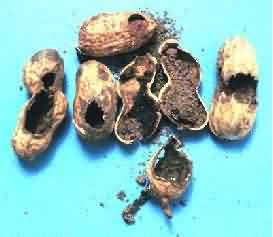 8. Termite
8. Termite
Damage
Termites are white translucent ant like insects. They enter the root system and burrow inside the root and stem; this usually kills the plant. They bore holes in the pods and damage the seed.
They remove the soft corky tissue from between the veins of the pods (scarified). They do not usually damage the seed. But scarified pods are more susceptible to infestation by Aspergillus fungus, which produces health hazard aflatoxins.
Management
- Destroy termite nests by clean cultivation.
- Seed treatment with Chlorpyriphos.
- Drenching of termite nests with Chlorpyriphos solution.
- Application of Carbofuran or Chlorpyriphos to the soil using 1 kg a.i. /ha at planting time can reduce termite incidence.
10 Ground Nut Bruchid
Damage
The adult is a brown beetle. Small translucent milky-white eggs can be seen attached to the pod wall. The larva burrows through the pod wall, and starts eating the seed.
Fully grown larvae often leave the storage sack and pupate in large numbers at the bottom of the pile of sacks.
The first sign of attack is the appearance of 'windows' cut into the pod wall by the larva. The larva burrows through the pod wall, and eats the seeds. Thus, groundnut seeds are too badly damaged for human consumption or oil expulsion.
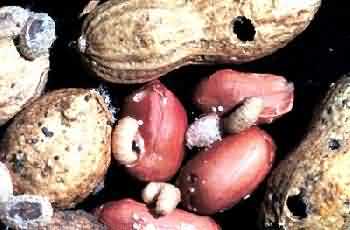
Management
- Drying the pods to less than 10% moisture before storing.
- No live insect pests are present in the produce or in the storage areas.
- Spraying the bags with pods with DDVP (Nuvan) at 2 ml/ liter of water or dusting with 5% Malathion.
- Fumigation of pods with Aluminum phosphide (Celphos) at 3 g tablets per bag of groundnut (40 kg) and covering the sacks with polythene sheet for 5 days can effectively control bruchids without affecting the seed viability.
- Fumigation should be done only in well aerated places outside the residential areas or in seed godowns only.
9. Pod Sucking Bug
Damage
This bug feeds on pods left in the field to dry, or on stored pods. In storage this bug feed on seeds, perforating the pod with their rostrum. This causes the seeds to shrivel and increases the free fatty acid content of the oil, producing a rancid flavor. Thus, the quality of groundnuts, and also the keeping quality of groundnuts are affected.
Management of Storage Pests
- Maintenance of optimum moisture content (not >5%) is always critical in preventing the development of storage pests.
- For protection against these 2 storage pests groundnuts should be stored unshelled.
- If groundnuts are stored as seed, care should be taken to avoid breakage. Broken seeds should not be stored for long periods.
- Dusting with an inert substance such as clay dust can help to minimize storage insect problems. Fumigation of pods with Aluminum phosphide (Celphos) at 3 g tablets per bag of groundnut (40 kg) and covering the sacks with polythene sheet for 5 days can effectively control bruchids without affecting the seed viability.
- Fumigation should be done only in well aerated places outside the residential areas or in seed godowns only, under the supervision of plant protection specialist.
- This learning resources are still to be edited and likely to be modified according to new recommendations & area specific climate.
- Your suggestions to improve this learning resource are
- valuable for me to improve the presentation.
Authors:
Manoj Kumar Jat and Arvind Singh Tetarwal
Department of Entomology, College of Agriculture
CCS, Haryana Agricultural University, Hisar (Haryana)
